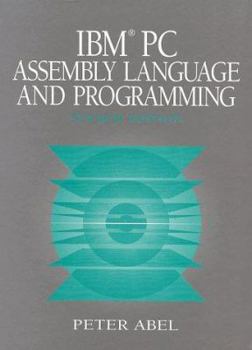IBM PC Assembly Language and Programming
Select Format
Select Condition 
Book Overview
A beginning through intermediate text for assembly language programming. Covers fundamentals of assembly language, data manipulation, input/output, and advanced programming topics including macros,... This description may be from another edition of this product.
Format:Hardcover
Language:English
ISBN:0137566107
ISBN13:9780137566105
Release Date:January 1997
Publisher:Prentice Hall
Length:606 Pages
Weight:2.33 lbs.
Dimensions:1.1" x 7.3" x 9.5"
Customer Reviews
5 ratings
An Excellent Overview of Assembly Language
Published by Thriftbooks.com User , 21 years ago
While not perfect for the beginning x86 assembly language programmer, Abel's text is an excellent overview of the basic and intermediate concepts of x86 assembly. This text covers many of the commands of the x86 instruction set and is an excellent introduction to learning about various BIOS and DOS interrupts. Herein lies a slight problem with the text. Relying too heavily on the "old world" of DOS and Windows 95/98 (and possibly - depending on your system - Windows 2000), this text often takes for granted that you are running on an older Microsoft-based x86 system. As long as you can overcome this compatibility "hurdle", this text is an excellent source for learning about x86 assembly. It covers the topic of machine code, which is of prime importance for those who are interested in writing assembler and compilers (and for writing succinct assembly), and also has copious notes on all the instructions taught in the text.
Assembly for beginners and beyond
Published by Thriftbooks.com User , 22 years ago
Dear fellow readers: The concept of writing assembly programs frightens most programmers who have adjusted in writing software in a third generation language (e.g., Pascal, C). In fact I have read two other books in my quest to understand assembly. But this book is definitely the best I have came across. The author has broken down the assembly instructions into many chapters that can be useful in locating the subject of interest, and skipping those that do not pertain to the reader's interest. His explanation of the interrupts and their associated services are uncanny. He has organised them into modular format so that the programmer can write programs as though he/she is connecting a large jigsaw puzzle. To my experience this made reading and writing assembly much easier task.
This book is obviously not good for self-study purposes
Published by Thriftbooks.com User , 25 years ago
I used this book as the textbook required in my Assembly class. With the help of this book I had a lot of trouble getting started. It was really killing me. But as I went on reading, I began to understand what the previous chapters were talking about. As I got a hang of it, the book became more and more useful and important to me. So This book is really good after all, but only if you don't give up in the beginning.
Good if you already have a good computer background...
Published by Thriftbooks.com User , 26 years ago
This book covers assembler programming very smoothly and in an easy-to-understand way. It goes step-by-step through each function and INT, giving good examples and explanations. You won't, though, understand it unless you already have some experience with higher-level languages.
Not exiting, but informative.
Published by Thriftbooks.com User , 27 years ago
The book is a complete reference on assembly language instructions, operands and data types. Sadly, only programming in real mode is covered and protected mode is left out. There also is nothing on DMA. However, the book makes up for this but being crystally clear in it's examples and explanations; the book is meant to serve not only as a reference but also as a tutorial, and therefore has little programs in assembly code scattered around to type in and assemble. At the end of each chapter there are quiz-type questions on the material in case you wish to test your knowledge. Yes, it is possible to learn assembly language well through this book.






